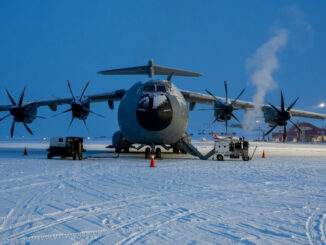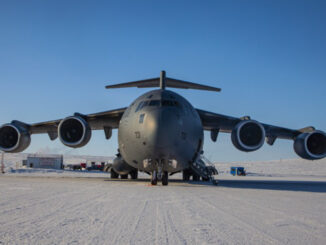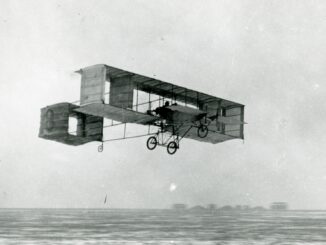 On 8ᵗʰ August 1934, James R. Ayling and Leonard G. Reid flew from Wasaga Beach in Ontario, Canada, to Heston Airfield, in the vicinity of London. It was the first non-stop flight between mainland Canada and England, as well as the first transatlantic flight to depart from the Canadian continental area.
On 8ᵗʰ August 1934, James R. Ayling and Leonard G. Reid flew from Wasaga Beach in Ontario, Canada, to Heston Airfield, in the vicinity of London. It was the first non-stop flight between mainland Canada and England, as well as the first transatlantic flight to depart from the Canadian continental area.
Although the milestone flight was completed by Ayling and Reid, the story began two years earlier with a different flight crew.
On 29ᵗʰ July 1932, two well-known aviation pioneers, Jim Mollison and Amy Johnson, got married in Dingwall, Scotland. Rumour has it that Mollison, impressed by Johnson’s record-breaking flights, proposed to her only eight hours after they met.
One year later, the ´flying sweethearts´, as the couple were nicknamed, made their first attempt to break the world record for flight distance, previously set by the French at 9,105.02 kilometres (5,657.6 miles). On 22ⁿᵈ July 1933, Mollison and Johnson took off from Pendine Sands in South Wales, flying a de Havilland DH.84 Dragon named ´Seafarer´ and headed to Brooklyn, New York. The couple hoped to spend a few days in the city, after the arrival, and then to continue the flight in the opposite direction and eventually reach Baghdad.
However, the weather ruined their plans. Throughout the crossing to the USA, the flying couple battled strong headwinds and the aeroplane was burning fuel too quickly. Eventually, they reached the American continent and decided to land in Connecticut, around sixty miles short of their planned destination.
In a desperate attempt to find a suitable landing field during the night, they flew too low and crashed in a marshy area near Bridgeport. Fortunately, the flying sweethearts were only slightly injured, but the aircraft was damaged beyond repair.

Undeterred by the crash, Mollison and Johnson acquired another DH.84 aircraft, named ´Seafarer II´, and made a second attempt to break the record. This time, they intended to begin their journey from Canada, taking off from Wasaga Beach in Ontario.
Their departure was witnessed by a crowd of local citizens and representatives of the de Havilland company. Regrettably, the second attempt was also ruined by the weather – specifically, a strong crosswind. The first two take-offs failed, and only on the third attempt did the aircraft manage to get airborne. However, it was just a short hop. A hard landing followed shortly after, damaging the undercarriage of the Dragon and rendering it impossible to continue.
The flying couple abandoned further attempts to fly from Canada to Baghdad and returned to England. The following year, they set a new record time for a flight from Britain to India, flying a de Havilland DH.88 Comet.
Nevertheless, Mollison and Johnson had merely closed the first chapter of the transatlantic story. In May 1934, Seafarer II was purchased by Englishman James R. Ayling and Canadian Leonard G. Reid, who decided to follow in the footsteps of the flying couple.
With the assistance of the de Havilland team, the new owners made several modifications to the aircraft, preparing it for a record-breaking flight. They renamed the aeroplane Trail of the Caribou and decided to depart from the same starting point – Wasaga Beach.
On 8ᵗʰ August 1934, despite strong winds, the DH.84 successfully took off for its flight to Baghdad. Initially, Ayling and Reid planned to alternate piloting duties in three-hour shifts, but after the first rotation, they shortened it to two hours – it proved too exhausting to remain at the controls for three hours continuously.

Regrettably, the flight did not go according to plan from the very beginning. Problems with setting the engine throttles emerged as the first major issue, which meant the aircraft could not maintain an economical cruising speed. Once Ayling and Reid resolved the throttle issue, they encountered dark fog and were forced to fly blind for around eight hours.
When the crew decided to climb above the fog, they faced an icing issue which caused the throttles to freeze in the open position. As a result, their fuel consumption increased by approximately 70 percent, from the estimated ten gallons per hour.
After around twenty-four hours of flight, the DH.84 reached Ireland. Exhausted and with fuel running low, Ayling and Reid turned towards England to find a landing site.
On 9ᵗʰ August 1934, in the afternoon, Ayling and Reid landed at Heston Airfield near London. They had spent 30 hours and 55 minutes in the air, covering a distance of 5,955 kilometres (3,700 miles). At the time of landing, only around 200 gallons of fuel remained in the tanks of their Dragon aircraft.
Although Ayling and Reid did not break the distance record or reach Baghdad, they achieved an important milestone in Canadian aviation. The flight of the Trail of the Caribou was the first non-stop flight between mainland Canada and England, and the first transatlantic flight to begin from the Canadian continental area.
Their flight was officially designated a National Historic Event of Canada. A commemorative cairn and plaque were erected at Wasaga Beach in 1958 to honour Ayling’s and Reid’s achievement.
Regrettably, the Trail of the Caribou did not survive long after the historic flight. On 12ᵗʰ August 1934, Reid crash-landed the Dragon aeroplane while flying with a passenger. Although no injuries were reported, the aircraft was damaged beyond repair.
Cover photo: de Havilland DH.84 Dragon G-ACJM, as bought by Reid in May of 1934 (photo: San Diego Air and Space Museum, AL61A-465, via Flickr Commons)



